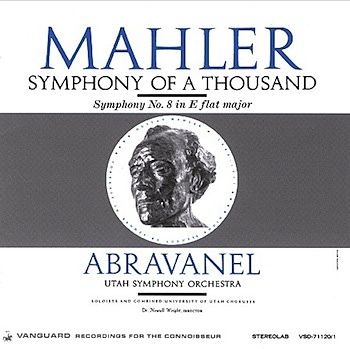A look back, toward the future….

The Birth of a Legacy
Although the Utah Symphony had made nearly twenty recordings before 1963 (including the Grammy nominated LP of Le Roi David by Honegger on Vanguard, 1961), a case can be made that the legacy of Maurice Abravanel and the Utah Symphony truly begins with the recording of Mahler’s Eighth Symphony (12.63). This landmark recording was the first commercial stereo recording of the work ever made. An astonishing achievement considering the context in which it was made, 50 years ago last month.
Mahler’s music did have it’s champions in the early 20th century. Conductor’s like Horenstein, Klemperer, Mengelberg, Mitropoulos, and Walter all programmed Mahler’s music regularly (Bernstein, despite his veracity and publicity, was a latecomer to the party). But in contrast to cities like Amsterdam, New York and Vienna where Mahler’s music was often performed, Salt Lake City had experienced relatively few performances of the composers works prior to 1963 (1st, 2nd and 4th Symphonies, Das Lied von der Erde, and Lieder eines fahrenden Gesellen).
The Utah Symphony’s earliest recordings were on the Westminster Label, which by the early 1960’s was on it’s way out of business. Vanguard Records was founded in 1950, and had a catalog that featured classical, blues and folk recordings. Abravanel and the Utah Symphony began recording for the label when the relationship with Westminster dissolved. As a small, independent label, Vanguard didn’t have the distribution of the major classical labels of the time. However, by 1963, Vanguard had reached an agreement with the Dutch label Philips for the Mahler Eighth recording to be distributed throughout Europe on the Philips label.
The Abravanel recording of Mahler’s Eighth Symphony was not only the first stereo recording of the work, but was also the first Utah Symphony recording to be widely distributed in Europe. The recording was well received by critics in both Europe and the US., which lead the way to recording the Seventh Symphony the following season.
The Mahler Seventh recording (1964) was also the first stereo recording of the work, and like the Eighth was distributed on the Philips label in Europe. Both recordings received international radio airplay and positive reviews in the New York Times, The Guardian (London), High Fidelity, the American Record Guide and Records and Recording (London), drawing comparisons with the top conductors and orchestras of the day. For these early Mahler recordings, Abravanel received the “Mahler Award” from the Bruckner Society of America, and honorary membership into the International Gustav Mahler Society in Vienna.
As a result of the wider distribution of the Utah Symphony Mahler recordings, the orchestra was receiving unprecedented attention, both at home and abroad. This helped generate the impetus that led to the orchestra’s first European tour. That first tour in 1966, less than 3 years after the Mahler Eighth recording, propelled the orchestra into the international spotlight. With guest soloists Gina Bachauer, Grant Johannesen and David Oistrakh, the tour, which began with the orchestra’s Carnegie Hall debut, took Abravanel and the Utah Symphony to Europe’s music capitols with much acclaim.
The 1963 Mahler Eighth recording set into motion the wheels of the Abravanel/Utah Symphony legacy. A risky venture for a largely unknown orchestra and an upstart record company paid off in spades. Abravanel and the Utah Symphony went on to make over 80 more recordings, embark on 3 more international tours, and travel across the U.S. from coast to coast. Together they established a place in the ranks of America’s major orchestras. A legacy that began 50 years ago with the Mahler Eighth recording, and continues to this day.
© 2013 Corbin Johnston
